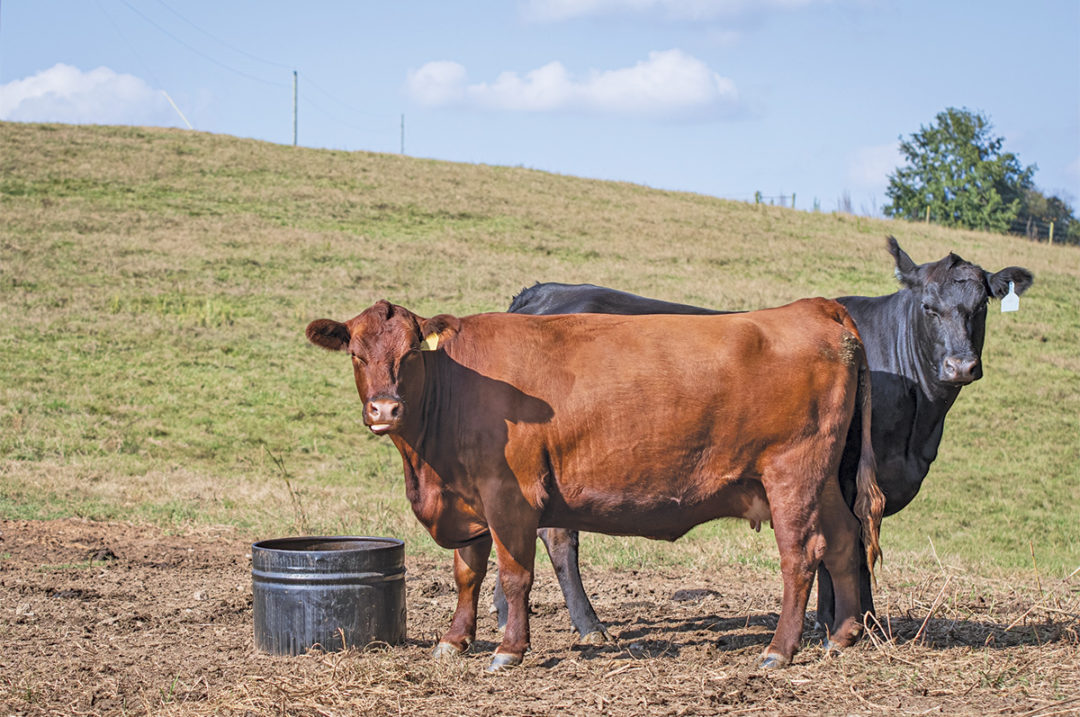Early embryonic loss is defined as a loss within the first 42 days of pregnancy and has been reported to impact between 20% and 40% of pregnancies in beef cattle. While it is a challenge to pinpoint the reason for these early embryonic losses, there are several management practices that may be altered to help alleviate the risk.
Vaccination timing
A good vaccination program is a valuable tool to protect the cow herd against infectious reproductive diseases. Modified-live virus (MLV) vaccines are popular because they create a faster, more robust immune response in comparison to killed vaccines. However, recent research has shed light that even in well-managed herds receiving annual boosters, an MLV vaccine given within 30 days prior to the start of the breeding season can have a negative impact on artificial insemination (A.I.) and first-cycle bull bred conception rates. Literature suggests that the vaccination is altering corpus luteum development and therefore hindering pregnancy establishment rather than causing embryonic losses. Administering pre-breeding shots at least 45 days ahead of the breeding season has been shown to lessen the impact that MLV can have on first-cycle conception rates.
Cattle handling
Although only around 12% of the U.S. cow herd undergoes A.I. annually, handling cattle during or immediately following breeding can increase cortisol levels, which could be detrimental to fertilization rates and embryo quality. Recent research suggests that elevated cortisol levels can alter ovulation timing, impacting A.I. success.
Additionally, the stress associated with handling for early pregnancy check (i.e., 35 days post-A.I.) is also perceived to have a negative impact on first-cycle bull-bred females (i.e., approximately 14 days bred). In general, heifers appear to be more susceptible to cortisol levels impacting pregnancy rates than cows; however, genetics, docility and other factors come into play as well.
Transportation stress
In many cases, grass turnout coincides with the start of breeding season. Research suggests that shipping females between five and 42 days post-A.I. can cause about a 10% loss in pregnancy with an additional 6% loss between days 45 and 60. Therefore, if hauling is necessary, cattlemen should wait approximately 48 hours post-A.I. to haul to avoid further increasing cortisol levels, which could impact ovulation timing and fertilization. Transporting females between days 2 and 4 post-breeding is believed to be the ideal timing to haul A.I.'ed females, since the embryo is still in the oviduct and less susceptible to stress and associated uterine changes. Another option is to wait until after 60 days post-breeding when the embryo is fully attached to the uterus, supported by the dam and, ultimately, less susceptible to stress.
If necessary to transport pregnant cows during critical periods of embryo development (days 5 to 60), take care to minimize animal stress by using low-stress cattle-handling methods: avoiding overcrowding on trailers, limiting time standing in the facilities or on the trailer, and considering time of day when handling. Guidelines from the Beef Quality Assurance program recommend 16 to 18 square feet per mature cow during transportation and not standing in facilities longer than 30 minutes.
Heat stress
Both the beef and dairy industries have noted heat stress within the first 16 days post-breeding can result in up to 30% pregnancy loss, depending on the severity of the event. Heat stress events cause body and uterus temperature to rise and decrease blood flow to the uterus, creating an unfavorable environment for the embryo, leading to decreased fluids, embryo weight and, ultimately, viability. One 10-year study in Nebraska even found that for every 1ºF above the normal average, season-long pregnancy rates tended to be reduced by 1%. Bull fertility can also be negatively impacted by heat stress and result in poor pregnancy rates.
If handling or hauling bred females during heat periods, it’s best to do so in the early morning hours. It takes at least six hours for cattle to dissipate their heat load, so handling in the evening hours should be avoided, as cattle have not recovered from the daytime stress.
Cattle on pasture are generally less susceptible to heat stress than those in lots. Providing adequate shade, water and airflow is critical to combating heat stress. Recommendations include allowing 20% to 25% of the herd to drink at once and offering 20 to 40 square feet of shade per cow.
Managing nutrition and environment
Taking a proactive approach to managing nutrition and body condition scores also helps ensure more females conceive earlier in the breeding season and maintain a healthy pregnancy. Approximately 60 days prior to the breeding season, females should be evaluated for condition and a supplementation plan developed accordingly to maintain a positive plane of nutrition. Nutrient restriction following A.I. or the start of the breeding season can have negative impacts on embryo development. Consider continuing to supplement mature cows for up to three weeks after turnout to help maintain some consistency in diet with a long-term supplement program for first-calf heifers due to higher nutrient requirements.
Avoiding environmental changes aligning with the start of the breeding seasons can also help preserve more early pregnancies. Data has shown that heifers going from a drylot setting to a grazing situation immediately following A.I. have about a 10% decrease in conception rates due to dietary changes and increased activity leading to a negative energy balance. Many producers have found success in utilizing cool-season annual forages as a grazing opportunity ahead of summer pastures. Establishing breeding groups ahead of A.I. or bull turnout also allows cows to determine their pecking order and avoid elevated stress levels near conception.









